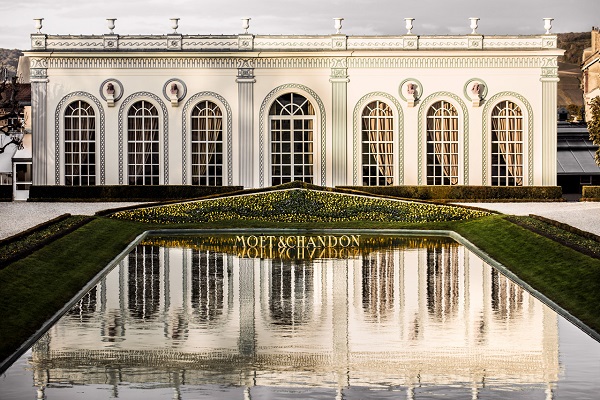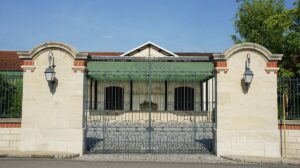The Founding of Moët & Chandon
Moët & Chandon was established in 1743 by Claude Moët, a wine trader from Épernay, who recognized the potential of the sparkling wines from the Champagne region. With a vision to bring these wines to the royal courts of Europe, Claude Moët laid the foundation for what would become one of the most renowned champagne houses in the world. His commitment to quality and excellence quickly set Moët & Chandon apart from its competitors.
Early Growth and Expansion
Claude Moët’s entrepreneurial spirit and keen business acumen led to the rapid growth of the house. By the mid-18th century, Moët & Chandon had established a strong presence in the European markets, particularly in the French and English royal courts. The house’s reputation for producing exceptional champagne continued to grow, attracting a prestigious clientele and solidifying its status as a leading champagne producer.
The Arrival of Jean-Remy Moët
Jean-Remy Moët, Claude Moët’s grandson, played a pivotal role in the further expansion and global recognition of the house. Taking over the family business in the early 19th century, Jean-Remy was instrumental in introducing Moët & Chandon to new markets and increasing its production capacity. His innovative approach and dedication to quality helped establish the house’s enduring legacy.
Under Jean-Remy’s leadership, Moët & Chandon acquired extensive vineyards in the Champagne region, ensuring a steady supply of high-quality grapes. He also expanded the cellars beneath Épernay, creating one of the largest and most impressive champagne cellars in the world. These developments were crucial in maintaining the house’s commitment to excellence and consistency.
Napoleon Bonaparte and Moët & Chandon
A significant milestone in the history of Moët & Chandon was its association with Napoleon Bonaparte. The French emperor was an ardent admirer of the house’s champagne and developed a close friendship with Jean-Remy Moët. This relationship not only enhanced the house’s prestige but also popularized Moët & Chandon across Europe.
Napoleon’s visits to the Moët estate and his famous endorsement of the champagne contributed to its legendary status. The tradition of sabering a bottle of champagne, attributed to Napoleon’s cavalry officers, further cemented Moët & Chandon’s association with celebration and victory.
The Creation of Dom Pérignon
One of the most iconic contributions of Moët & Chandon to the world of champagne is the creation of Dom Pérignon, its prestige cuvée. Named after the legendary Benedictine monk Dom Pierre Pérignon, who made significant advancements in the production of champagne, this exceptional wine was first introduced in the early 20th century.
Dom Pérignon is renowned for its complexity, elegance, and aging potential. Produced only in exceptional vintages, this champagne exemplifies the pinnacle of Moët & Chandon’s craftsmanship and dedication to excellence. The creation of Dom Pérignon has solidified the house’s reputation as a producer of some of the finest champagnes in the world.
Challenges and Resilience
Like many historic champagne houses, Moët & Chandon faced numerous challenges throughout its history, including wars, economic downturns, and changes in consumer preferences. Despite these obstacles, the house demonstrated remarkable resilience and adaptability. During World War I, Moët & Chandon’s cellars served as shelters for soldiers, and the house played a crucial role in supporting the war effort.
In the post-war era, Moët & Chandon focused on rebuilding and expanding its global reach. The house’s commitment to quality and innovation enabled it to navigate these turbulent times and emerge stronger. Strategic acquisitions, such as the merger with Hennessy in 1971 and the creation of the LVMH group in 1987, further enhanced Moët & Chandon’s position as a global leader in luxury wines and spirits.
Modern Era and Global Recognition
Today, Moët & Chandon is synonymous with luxury, celebration, and excellence. The house continues to build on its rich heritage while embracing modern advancements in viticulture and production. Sustainability has become a key focus, with initiatives aimed at reducing the environmental impact of champagne production and promoting biodiversity in the vineyards.
Moët & Chandon’s champagnes are celebrated worldwide for their quality, consistency, and elegance. The house’s flagship Brut Impérial, with its balanced profile and vibrant flavors, remains a favorite among champagne enthusiasts. Other notable offerings, such as the Rosé Impérial and Grand Vintage collections, showcase the house’s versatility and expertise in creating exceptional champagnes.
Iconic Champagnes of Moët & Chandon
Moët & Chandon produces a range of champagnes that have become iconic representations of the house’s excellence. The Brut Impérial, a blend of Pinot Noir, Pinot Meunier, and Chardonnay, is known for its harmonious balance and bright fruit flavors. The Rosé Impérial, with its expressive red fruit notes and elegant structure, is another standout in the house’s portfolio.
The Dom Pérignon prestige cuvée, produced in limited quantities from the best grapes of a single vintage, embodies the pinnacle of Moët & Chandon’s craftsmanship. This champagne is celebrated for its complexity, depth, and aging potential, making it a symbol of luxury and refinement.
The Legacy of Moët & Chandon
Moët & Chandon’s legacy is one of innovation, resilience, and an unwavering commitment to excellence. From its founding in 1743 to its current status as a global icon, the house has played a pivotal role in shaping the history and development of champagne. Its rich heritage, combined with a forward-looking approach, ensures that Moët & Chandon will continue to be a symbol of luxury and celebration for generations to come.
The story of Moët & Chandon is not just a chronicle of a champagne house; it is a testament to the enduring appeal of champagne itself. From its humble beginnings to its current status as a global icon, Moët & Chandon’s journey reflects the passion, creativity, and dedication that define the world of fine champagne.
Read also: 10 of the oldest Champagne houses that still exist
𐡸 𐡸 𐡸 𐡸 𐫱 𐡷 𐡷 𐡷 𐡷
Frequently asked questions
Moët & Chandon stands out for its rich history, association with notable historical figures like Napoleon Bonaparte, and its creation of the prestigious Dom Pérignon champagne. The house’s commitment to quality, innovation, and sustainability further distinguishes it in the world of champagne.
Dom Pérignon is Moët & Chandon’s prestige cuvée, named after the legendary monk Dom Pierre Pérignon. Produced only in exceptional vintages, Dom Pérignon is celebrated for its complexity, elegance, and aging potential, representing the pinnacle of the house’s craftsmanship.
Moët & Chandon is dedicated to sustainability through various initiatives, including reducing its carbon footprint, promoting biodiversity, and implementing eco-friendly viticulture practices. These efforts ensure the long-term health of its vineyards and the surrounding ecosystem.
Moët & Chandon Brut Impérial is known for its harmonious balance, vibrant fruit flavors, and fine mousse. It is a blend of Pinot Noir, Pinot Meunier, and Chardonnay, offering a consistent and elegant profile that appeals to a wide range of champagne enthusiasts.
Jean-Remy Moët, the grandson of the founder Claude Moët, played a crucial role in expanding and globalizing the champagne house. His innovative approach, acquisition of extensive vineyards, and expansion of the cellars beneath Épernay helped establish Moët & Chandon’s enduring legacy and reputation for excellence.



